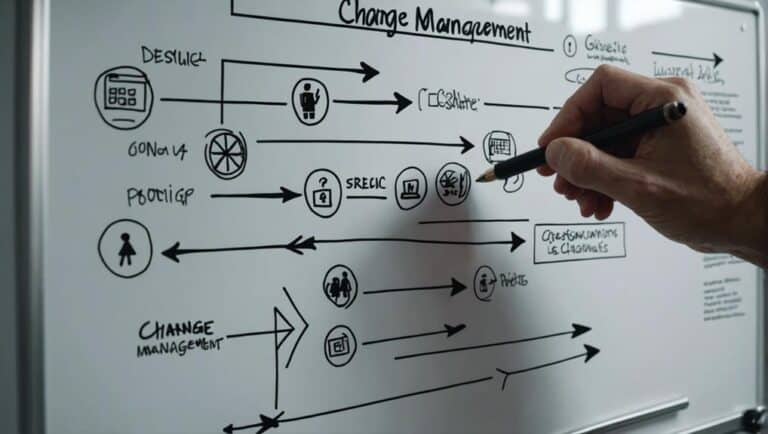When considering change management it’s easy to get lost in the processes and logistical issues and forget about the human impact the end result of the change will have. You could execute a brilliant project, but it might not deliver the impact you’d hoped for if the rest of the company isn’t on board. So just why is it so difficult for individuals to accept change?
People resist change because they fear the unknown, they are comfortable with the status quo, or they don’t have the necessary skills to adapt. Businesses find it hard to let go of old processes and procedures that may no longer be effective. They also struggle when trying to implement new technologies or systems that require employees to learn new ways of working.
To overcome these challenges, organisations need to communicate the benefits of change clearly, provide training and support where needed, and create a culture that embraces innovation.
What is the fear of change and why does it exist?
The fear of change can be a powerful thing. It can cause people to retreat into their comfort zones and stick with the status quo, even when it’s clear that things need to change.
It is a natural response that often occurs when people or companies are faced with something new. This feeling can lead to a negative chain reaction because change represents the Unknown. When people are presented with something new, their first instinct is often to retreat to what is familiar and known.
Of course, this isn’t always a bad thing. After all, there’s comfort in the familiar – which is why so many of us find it difficult to make changes in our lives (even when we know we should).
However, when it comes to business settings – particularly senior management within businesses – resisting change can be detrimental.
This is because businesses must constantly adapt and evolve in order to stay competitive. If they don’t embrace new ideas and ways of doing things, they’ll quickly fall behind their rivals who are more willing to take risks and experiment with new approaches.
Change management should be comprehensive in order to reduce anxiety and help people feel more comfortable with the process.
The fear of change is real and often stems from a lack of control. People may feel anxious about what the future holds, especially if they don’t feel like they have a say in how things are changing. However, this fear can be overcome with open lines of communication and a well-planned change management process.
Change should be celebrated even when it’s difficult because it represents progress and forward momentum.
Resistance to change is often due to insecurity and a lack of understanding, but by taking things one step at a time, organizations can make the transition smoother for everyone involved.
How does the fear of change manifest itself in people and organizations?
Fear of change can prevent people and organizations from adapting to changing market conditions or new technologies, even when the change is a common sense one.
Change management is the process of adapting to change, and it can be managed effectively with the right tools and methods.
The three common problems in change management are inertia, perception of risk, and resistance to change.
Inertia is when people or organizations fail to act because they don’t want to deal with the hassle or discomfort of change.
Perception of risk is when people or organizations are afraid that the benefits of change won’t outweigh the risks.
Resistance to change is when people or organizations are against any changes, regardless of the benefits.
If you can address each of these key factors, you can reduce issues caused by resistance to the introduction of something new.
What are the consequences of succumbing to the fear of change?
There are several consequences that can result from succumbing to the fear of change. One such consequence is stagnation.
When people or organizations resist change, they eventually stop growing and evolving. This can lead to a loss of competitiveness in the market, as well as a decrease in innovation and creativity.

In addition, refusing to change can also breed unhappiness and dissatisfaction among employees, which can lead to a lack of trust between team members, impeding collaboration and communication and may even cause them to leave the company.
Lastly, resisting change can also have financial implications, as it may prevent an organization from taking advantage of new opportunities or technologies and could cause delays in project milestones and ultimately lead to less successful outcomes.
If you want to be successful with change management, it’s important not to let “the fear” get in the way.
It’s clear that there are many risks associated with not embracing change. People and companies who refuse to adapt will eventually stagnate and become irrelevant. They’ll lose their competitive edge in the market, and their employees will be unhappy and unproductive.
Why is it so difficult for individuals and companies to accept change?
There are many reasons why change can be difficult for individuals and companies to accept. One reason is that humans are genetically wired to look for patterns and predictability. When something is new, it is not part of our normal routine, and therefore it creates fear because we do not know what the outcome will be. This fear of the unknown leads to resistance, which is rooted in our natural desire to find patterns.
Another reason people resist change is because they are afraid they will lose their jobs or that the company will go bankrupt if things don’t stay the same. This fear often causes people to cling to the status quo even when it’s no longer working.
Additionally, individuals resist change in different ways than corporations do. Personal resistance is often subtlety while corporate resistance is more overt.
People also resist change because it comes at the expense of their existing skill sets and relationships. They may feel like they are being forced into a new situation where they have no control over what happens next.
There is also a common issue with inertia, which is a powerful force — both in nature and in organizations.
Once people become accustomed to a certain way of doing things, it can be difficult for them to move out of their comfort zone thanks to the status quo bias.
The status quo bias is a cognitive bias that dictates that people are more likely to favor things staying the same, rather than changing.
It can be seen in both individuals and organizations – once something has become the norm, it can be difficult for people to move out of their comfort zone and accept change.
There are numerous reasons why the status quo bias exists, but one of the main reasons is because humans are creatures of habit. As mentioned above, we like routine and predictability because it makes us feel safe; when something disrupts our routine, it can cause anxiety or even fear.
Change also requires effort, whether it’s learning new information or physically altering our behavior, which can be daunting for some people.
Finally, we tend to underestimate how much we will benefit from change while overestimating the costs (both real and perceived).
When faced with these types of trade-offs, it’s no wonder why so many people opt for sticking with what they know.
How can people and organizations overcome the fear of change?
There are a number of ways that people and organizations can overcome the fear of change. One way is to go big and introduce new initiatives in a top-down manner.
Atlassian did this by introducing a new performance management system throughout the company, from the top down. This helped to ensure that everyone was on board with the changes and that there was buy-in from all levels of the organization.
Atlassian’s change management initiative was spurred from an internal observation that revealed some areas where the company could improve its performance management process. Transparency is key when it comes to change management, and Atlassian made sure to communicate the changes internally so that employees could quickly adopt them.
Another way to overcome resistance to change is through training for managers. Atlassian invested in training for managers, so they could effectively coach employees on how to achieve their personal bests across their careers. This type of training helps employees understand why changes are happening and how they can benefit from them.

Change at Google began at the top, as they were accountable for financial risks associated with making changes. In order to help mitigate these risks, Google invested in technology solutions such as a new performance management system and an investment in using technology to identify, hire, and promote talent. By leveraging technology, Google was able to make changes quickly and efficiently across all parts of the company.
All change initiatives should be transparent to the public and readily communicated internally for quick adoption by employees. This way, everyone is on board with the changes and there is buy-in from all levels of the organization.
The examples of successful change management that we discussed in the passage were not always smooth. However, some organizations and people are more successful than others when it comes to change management. It’s important to remember that not everyone will be happy with every change, but it’s important to push forward and overcome resistance to change in order to achieve success.
What are some successful examples of companies or individuals who have embraced change?
In order to be successful, a company must embrace change. This can be a difficult task for many people and organizations, as the fear of change often prevents them from taking risks.
However, there are many examples of companies and individuals who have successfully embraced change and achieved great things.
American Airlines merged with US Airways, which created an overlap in technology and programs. This allowed the two airlines to work together more efficiently and improve their customer service.
Starbucks implemented a new coffee ordering system that enabled customers to order and pay for their drinks through the Starbucks app. This saved customers time and made the process easier overall.
Borders is a good example of a company that failed to change and went bankrupt due to competition with online sales; they were trying to compete with Barnes & Noble, but they didn’t have the e-reader that B&N had in place already (which gave them an advantage). Borders’ e-reader was too little, too late to make a difference. Borders resisted change, chose not to build up its own e-commerce capabilities, and suffered the consequences.
Successful change efforts focus on how the company can benefit through their change. Failure to adapt and evolve often leads to stagnation which can lead to failure or bankruptcy. As long as a company is willing to learn from its mistakes, it has a chance at success.
What can be done to help people overcome their fear of change?
Change is inevitable. No matter what you think, at some point your business will go through a change. It may not be one you expected, it may be caused by outside forces, but change will happen.
Employees may feel uncomfortable about changing jobs, moving locations, or taking on new responsibilities. Here are five tips for helping employees overcome these fears and embrace change in the workplace.
1. Be Honest With Them
It’s important to be honest with your employees about what change means for them. If you don’t tell them up front, they may think there’s something wrong with them.
They may feel insecure about their job security or worried about losing their current benefits.
Be upfront with your employees about the changes you’re making and let them know what they mean for them.
2. Make Sure They Understand What’s Changing
Make sure your employees understand exactly what’s happening. Explain the changes in detail and answer any questions they may have.
This will give them a better understanding of what’s going on and allow them to prepare themselves for the transition.
Where possible, make sure everyone understands why and how the change will benefit them.
3. Give Them Time To Adjust
Give your employees ample time to adjust to the changes. This will help them avoid feeling overwhelmed and stressed out.
Don’t force them into a situation they aren’t prepared for. Allow them to take their time adjusting to the changes and learn how to adapt to the new system.
If there are any doubts or concerns, be willing to address them openly and honestly.
4. Involve Them in the Process
Make sure everyone has a voice and a seat at the table during decision-making processes. This doesn’t mean that every member of staff has a say, instead you can have a nominated representative attend who can provide input to the process and feedback to their team.
Involving individual people who can update others helps keep as many people as possible informed and makes them more likely to accept the change.
This will ensure that all stakeholders feel included and have a say in how things are going forward.
5. Provide Support
Ensure there is support for your employees during this transition. Let them know you care about them and want them to succeed.
Let them know you’re available to talk to them whenever they need to discuss anything related to the changes.
Offer your employees’ assistance if they need it. This could include providing training materials, answering questions, or offering advice.
Employees appreciate knowing they can turn to you for help. It shows you care about them and that you value their contributions.
When you provide your employees with information and resources, they’ll feel confident about the changes and more comfortable about embracing change.
6. Create A Positive Work Environment
Create a positive working environment. Your employees will feel more comfortable if they see you supporting them and encouraging them to do their best.
Show your employees that you respect them and value their opinions. Let them know you’re committed to helping them grow professionally.
Your employees will feel more secure and comfortable if they know you’re invested in their success.
Celebrate progress along the way! Let your employees know that you appreciate their efforts and acknowledge their accomplishments during times of change – this will help to build trust and promote collaboration.
Going through a difficult transition can be very challenging for employees, but by following these tips, you can help them overcome their fear of change and emerge victorious!
By creating a positive work environment, you’ll encourage your employees to embrace change and become more successful.
Conclusion
The fear of change is often driven by the fear of the unknown, it’s hardwired human behaviour. By removing as much of the unknown as possible via communication with employees you can reduce both employee resistance and the risk of failure.
To overcome resistance to change, it’s important to address peoples’ fears by communicating openly about what’s happening, why it’s happening, and how it’s going to benefit those involved.
Providing adequate training can also reduce anxiety by teaching people the new skills need to successfully navigate through the change.
Sources
https://en.wikipedia.org/wiki/Status_quo_bias
https://www.managementexchange.com/story/atlassians-big-experiment-performance-reviews
https://support.google.com/a/answer/9839340?hl=en
https://jcsr.springeropen.com/articles/10.1186/s40991-017-0021-0
https://money.cnn.com/2006/10/30/news/companies/walmart_setback/index.htm
https://www.reuters.com/article/us-borders-idUSTRE71F2P220110217





